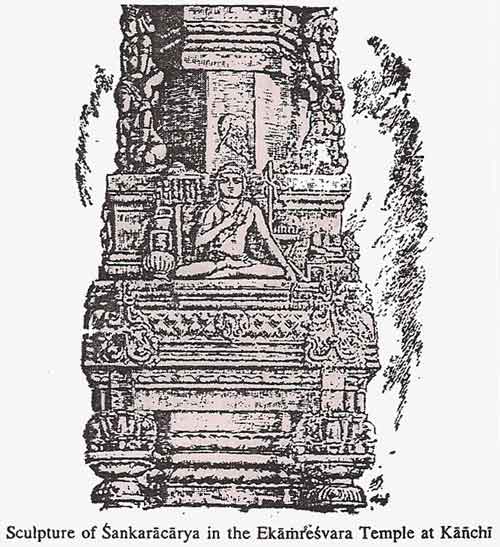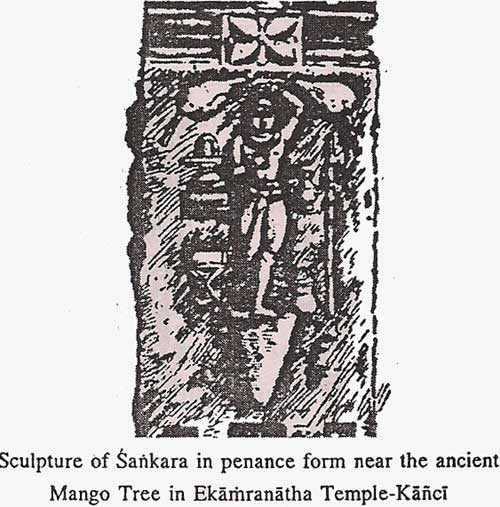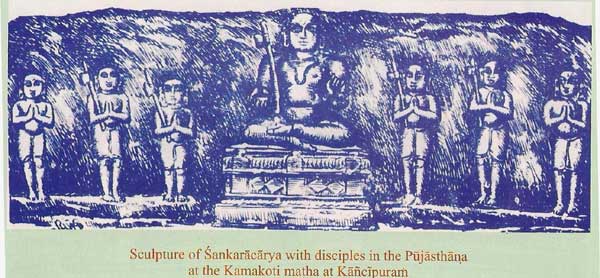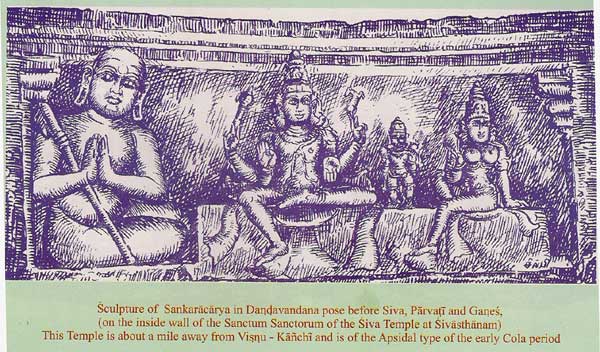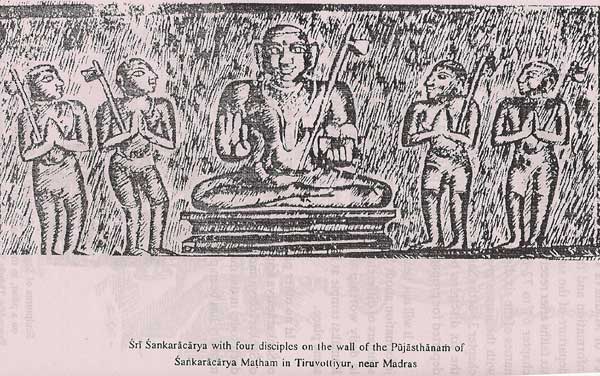Adi Shankaracharya & His Connection with Kanchipuram
A book By Sri A. Kuppuswami, B.A., B.T.
|
SRI SHANKARACHARYA AND HIS CONNECTION WITH KANCHIPURAM |
|
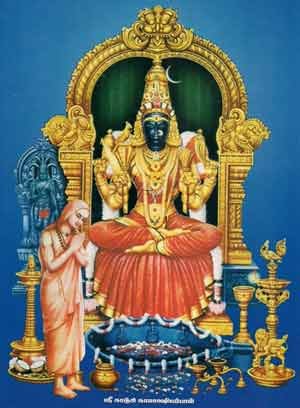 |
CHAPTER-6 In the Sacred city of Kanchi numberous sculptures of Sri Shankaracharya are to be seen to this day. These sculptures are found mostly in the temples of the city. Some of these stone images are large and some are small. Besides, they are of different poses. Moreover, they are found in almost all important temples irrespective of their being dedicated to Siva, Visnu or Sakti. Not only in Kanchi such sculptures are found but also in temples existing miles around. |
In the Kamakshi temple of Kanchi there is a life-size icon of Shankaracharya, on a raised small mantap to the north eastern side of the sanctum sanctorum of Devi Kamakshi. It is in daily worship. In this same temple, stone images of Sankara can be seen in the shrines of the Yatrotsava Kamakshi and Bangaru Kamakshi. 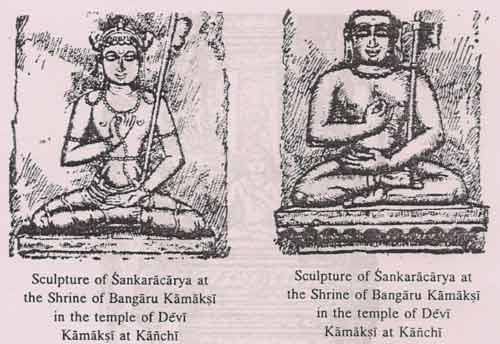 Very near the Kamakshi temple is the temple of Skanda, popularly known as Kumarakotam, wherein a Sankara Sculpture is found. About half-a furlong to the south – west of the Kamakshi temple stands the Kachapesvara temple where also a sculptured representation of Sankara is to be seen.
On the left side of the main entrance to the Ekamresvara temple in Kanchi, there is a small shrine for Ganesa. In this shrine also, there is a small stone image of Shankaracharya. An equisite sculpture of the Acharya is found on the front face of a pillar before the small sub- shrine of Siva, south – east of the huge Nandi inside the Ekamranatha temple. Around the figure of the Acharya are found ghata (small water vessel), an umbrella, a camera (whisk) a Sivalinga and a book on a stand. Another Sankara sculpture in the pose of performing penance (standing) along with a Linga, a book and whisks etc., distributed on all sides of the sculpture, is seen by the side of the time – honoured sacred mango tree(Mavadi) in the Prakara of Ekamranatha temple. A slightly larger stone image of Sankara, in a similar penance pose, can be seen in the Vaikunta Perumal temple in Siva – Kanchi. 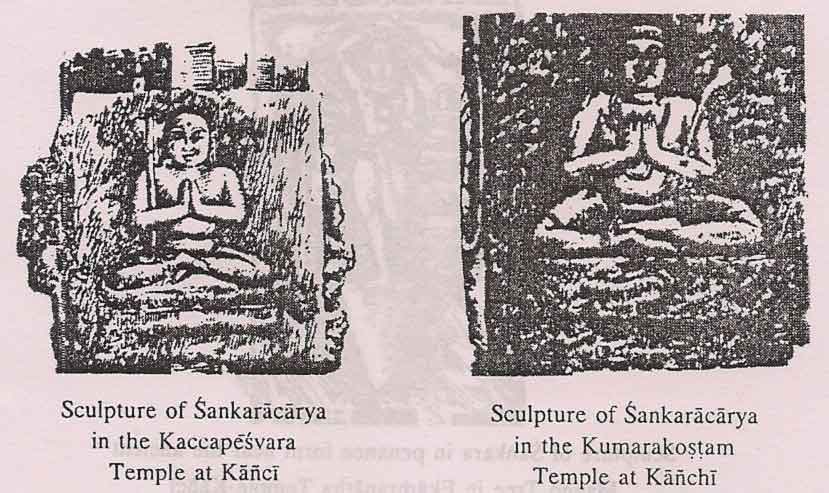 Stucco images of Sankara and Vyasa are seen in the Kailasanatha temple at Kanchi. In a sculptural panel in the Iravattanesvara temple at Kanchi one can see by the side of Daksinamurti ( in the centre), images of the old sage Vyasa and Sankara chiseled as a young boy in his early teens. 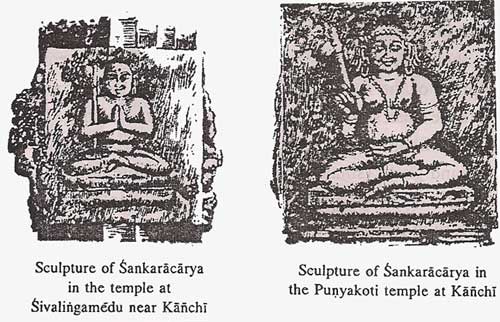  Sculptures of Sage Vyasa(sitting) and Sankaracharya(standing) on a pillar, in the mantap near the entrance to the shrine of Perundevi Thayar Shrine in Sri Varadaraja Temple at Vishnu-Kanchi In the Varadaraja temple in Visnu Kanchi, in a pillar on the mantapam before the shrine of Mahadevi the images of Vyasa showing one finger, as if denoting the advaita concept and Sankara standing near, have been chiseled. In the four pillared mantap, to the south of the Anantasaras tank in the same temple, there is a sculpture of Sankara in standing posture. In the Punyakotisvara temple in Visnu Kanchi there is a stone image of Sankara. In Srivasthanam temple, about a mile off Visnu Kanchi, there is a sculptural panel, in the wall inside the sanctum sanctorum, portraying Sankara as performing dandavandana (obeisance with the danda, the holy staff of anscetics) to Siva and Parvati. 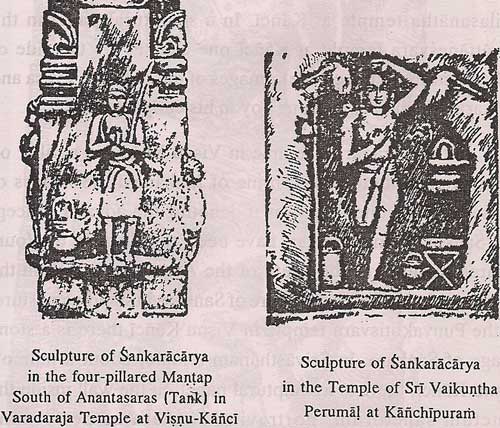 On the wall inside the sanctum of the Kamakoti Shankaracharya math at Kanchipuram, there is a sculptured image of Sankara flanked by six disciples. On the outer side of the shrine there are two fragmentary inscriptions, of the end of the 14th century, which refer to gifts of lands to the math by King Kampanna. In a village called Sevilimedu, some five kilometers away from Kanchi and even in distant places such as Pappancavadi, Poonamallee, Tiruvottiyur (near Madras) there are Sankara sculptures in the important temples of those places.
A note on the Shankaracharya – murti in worship at the Kamakshi temple and the one in the Shankaracharya Matha at Kanchi: 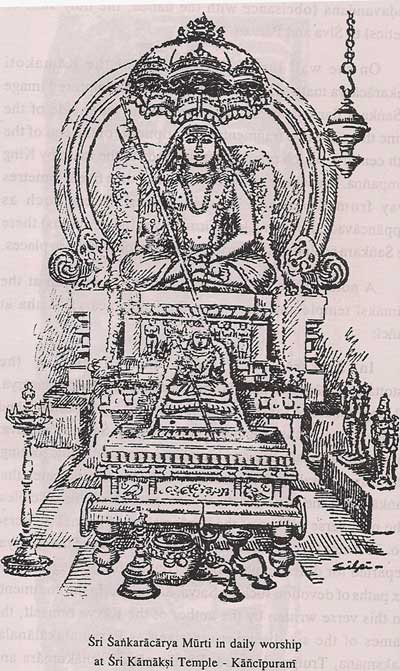 In Shankaracharya’s Laghunamavali and in the Astottarasatanamavali there is one name SanmatasthapanaAcharya. All biographers of Shankaracharya speak of his having established six devotional paths(Sagunopasana) namely, Saiva, Vaisnava, Sakta, Saura, Ganapatya and Kapalika on a sound Vedic footing. The Guruvamsakavya (in verse 34 of Canto III ) indicates that Sankara left the banks of the Tungabhadra with his disciples. The next verse speaks of the consecration of Kamakshi. Verse No.36 states that six disciples, after taking leave of the Acharya, departed for different parts of the country for propagating the six paths of devotion such as, Saiva, Sakta, etc. In the comments on this verse written by the author of the Kavya himself, the names of the six disciples are given as Paramatakalanala, Laksmana, Truipurakumara, Ravikumara, Girijakumara and Vatukanatha. The Dindima commentary on verse 174 of canto XV of Madhava’s Sankara – digvijaya too gives the same information and the same names of the six disciples. The departure of the six disciples from Kanchi for propogating the six faiths after receiving the blessings of Sankara, is narrated in chapter 67 to 72 of Anantanandagiri's Sankara-Vijaya. The names of the six disciples, as started in this work, are identical with the names given in the Guruvamsakavya. Ten verses in chapter 31 of the Sankaravijaya- vilasa of Cidvilasa describe how the six disciples bowed to Sankara and with his blessings departed for propagating the six paths of devotion. It will not be apocryphal to infer that this piece of uniform information about Sankara, given in four works, authored by scholars of different times, gets corroborated by the existence in daily worship of Shankaracharya with Six disciples in the Kamakshi temple at Kanchi and in the Shankaracharya Math of the same place. |
|
| Book Index Page | 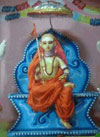 |
Appendix 1 - Some References to Shankaracharya in relation to Kanchi |
Back to Page - Focus Adi Shankaracharya
